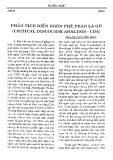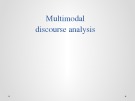
THE CHARACTERISTICS OF THE SYNTACTIC STRUCTURE OF
THE DESCRIPTIVE DISCOURSE CONCRETIZE THE
IDEOLOGICAL FUNCTIONTHROUGH THE ARGUMENT
PROCESS
Le Thi Thanh Uyen1*, Dinh Lu Giang1
1VNUHCM - University of Social Sciences and Humanities
*Corresponding author: Le Thi Thanh Uyen, lethithanhuyen2010@gmail.com
GENERAL INFORMATION
ABSTRACT
Received date: 07/03/2024
The literary text is the communication between the author
and the reader. When the author uses the
discourse to
actualize the experiences of what is happening around or
inside them. Descriptive discourse is the flexible discourse
genre, the multifunctional social entity. In discourse research,
the “dynamic” not only are personal thoughts and attitudes
realized, but the moral standards and social ideologies of the
community are also clearly realized. The approach, that
examines the discourse in the performing process of
communication functions concretized through the text.
Especially, the role of descriptive discourse in realizing the
experiential function related to the context Field through the
argument process. Using the Systemic Functional Grammar
theory, discourse analysis, and semantic analysis methods
helps us explain and extract the functional characteristics in
the sociocultural and situational contexts to recognize the
discourse in all functional aspects.
Suppose descriptive
discourse is used flexibly in communication. In that case, it
not only helps the user understand the beauty of a language
but also has interesting insights into the linguistic culture of a
nation.
Revised date: 16/04/2024
Accepted date: 30/05/2024
KEYWORD
Arguments;
Discourse & discourse analysis;
Literary genre;
Syntactic structure;
Textual.
1. INTRODUCTION
The discourse creates the text, so the text
is considered the communication event of the
social interactions, associated with the social
ideology to establish the links between the
structure of experience and the chain of the
hierarchical structures in the discourse system.
Therefore, modern and postmodern linguists
always emphasize the importance of
descriptive discourse in the realizing process
of each individual’s experience.
The research model of Systematic
Functional Grammar (SFG) theory becomes
the key to discovering the structural
characteristics that express the ideational
function of each person through the argument
process. That means, researching the
descriptive discourse is not pure research
based on individual factors but must be
138

























